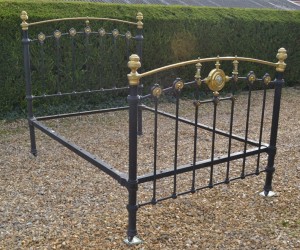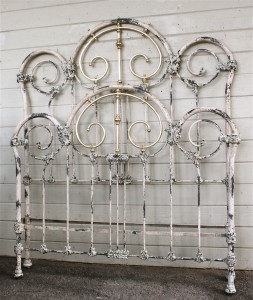
 To the untrained eye…..the construction of one metal bed is just as good as another. They’re both made of steel tubing and cast iron castings…..right? Certainly the difference between beds that were being made in England, back in the 1800’s, and one that was being made here couldn’t be that different…….could it? Well they couldn’t be more different…..there are major structural differences between the beds that we were making in this country, during the 1800’s, and those being made at the same time in England. There are three distinct differences between the majority of beds being made in America and those being made in England. The first major difference is the tubing….we used thick wall steel tubing, that gave structural strength to our beds. The British tended to use a much thinner wall tubing that was not as structurally sound and over the years has a tendency to split. The second difference are the castings….. we used a very high grade of iron ore, coming out of the steel mills of Pittsburgh PA, to make our castings. The Pittsburghsteel mills were well known for making the highest grade iron ore and steel tubing in the world. . Conversely the British used a combination of alloys that did not always stand the test of time. Some British castings won’t stand up to a standard sandblasting machine or a baking oven, used to cure the paint of some finishes. I’ve seen British beds that castings literally melted off the frame. The third major difference is the use of lot’s of thin brass to adorn the British beds and a lack of finely detail castings, which we were known for. Brass is not a structurally sound metal to build with and was only used in a decorative sense on American made iron beds. The British actually used it in a structural manner. Hence the noise from any movement in the bed, by all the screws and little brass balls used to attach the decorative tubing. These connecting points can work loose over time and the friction can cause a lot of squeaking and noise. American made beds have all their connecting joints secured with iron castings that were poured with hot liquid iron ore into moulds that were formed around the joints. That way, not only are they more decorative. But they also are far more secure and allow no friction or noise.
To the untrained eye…..the construction of one metal bed is just as good as another. They’re both made of steel tubing and cast iron castings…..right? Certainly the difference between beds that were being made in England, back in the 1800’s, and one that was being made here couldn’t be that different…….could it? Well they couldn’t be more different…..there are major structural differences between the beds that we were making in this country, during the 1800’s, and those being made at the same time in England. There are three distinct differences between the majority of beds being made in America and those being made in England. The first major difference is the tubing….we used thick wall steel tubing, that gave structural strength to our beds. The British tended to use a much thinner wall tubing that was not as structurally sound and over the years has a tendency to split. The second difference are the castings….. we used a very high grade of iron ore, coming out of the steel mills of Pittsburgh PA, to make our castings. The Pittsburghsteel mills were well known for making the highest grade iron ore and steel tubing in the world. . Conversely the British used a combination of alloys that did not always stand the test of time. Some British castings won’t stand up to a standard sandblasting machine or a baking oven, used to cure the paint of some finishes. I’ve seen British beds that castings literally melted off the frame. The third major difference is the use of lot’s of thin brass to adorn the British beds and a lack of finely detail castings, which we were known for. Brass is not a structurally sound metal to build with and was only used in a decorative sense on American made iron beds. The British actually used it in a structural manner. Hence the noise from any movement in the bed, by all the screws and little brass balls used to attach the decorative tubing. These connecting points can work loose over time and the friction can cause a lot of squeaking and noise. American made beds have all their connecting joints secured with iron castings that were poured with hot liquid iron ore into moulds that were formed around the joints. That way, not only are they more decorative. But they also are far more secure and allow no friction or noise.
Although initially attractive, the practicality of using a British made iron bed, on a regular basis is not good.







